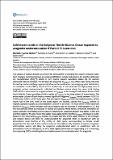Por favor, use este identificador para citar o enlazar a este item:
http://hdl.handle.net/10261/260267COMPARTIR / EXPORTAR:
 SHARE
BASE SHARE
BASE
|
|
| Visualizar otros formatos: MARC | Dublin Core | RDF | ORE | MODS | METS | DIDL | DATACITE | |

| Título: | Cold-water corals in the Subpolar North Atlantic Ocean exposed to aragonite undersaturation if Paris 2ºC is not met |
Autor: | García-Ibáñez, Maribel I. CSIC ORCID ; Bates, Nicholas R.; Bakker, D. C. E.; Fontela, Marcos CSIC ORCID; Velo, A. CSIC ORCID | Fecha de publicación: | 2021 | Citación: | EGU General Assembly (2021) | Resumen: | The uptake of carbon dioxide (CO2) from the atmosphere is changing the ocean’s chemical state. Such changes, commonly known as ocean acidification, include reduction in pH and the carbonate ion concentration ([CO32-]), which in turn lowers oceanic saturation states (Ω) for calcium carbonate (CaCO3) minerals. The Ω values for aragonite (Ωaragonite; one of the main CaCO3 minerals formed by marine calcifying organisms) influence the calcification rate and geographic distribution of cold-water corals (CWCs), important for biodiversity. In this work we use high-quality data of inorganic carbon measurements, collected on thirteen cruises along the same track during 1991–2018, to determine the long-term trends in Ωaragonite in the Irminger and Iceland Basins of the North Atlantic Ocean, providing the first trends of Ωaragonite in the deep waters of these basins. The entire water column of both basins showed significant negative Ωaragonite trends between -0.0015 ± 0.0002 and -0.0061 ± 0.0016 per year. The decrease in Ωaragonite in the intermediate waters, where nearly half of the CWC reefs of the study region are located, caused the Ωaragonite isolines to migrate upwards rapidly at a rate between 6 and 34 m per year. The main driver of the observed decline in Ωaragonite in the Irminger and Iceland Basins was the increase in anthropogenic CO2. But this was partially offset by increases in salinity (in Subpolar Mode Water), enhanced ventilation (in upper Labrador Sea Water) and increases in alkalinity (in classical Labrador Sea Water, cLSW; and overflow waters). We also found that water mass aging reinforced the Ωaragonite decrease in cLSW. Based on the observed Ωaragonite trends, we project that the entire water column of the Irminger and Iceland Basins will likely be undersaturated for aragonite when in equilibrium with an atmospheric mole fraction of CO2 (xCO2) of ~860 ppmv, corresponding to climate model projections for the end of the century based on the highest CO2 emission scenarios. However, intermediate waters will likely be aragonite undersaturated when in equilibrium with an atmospheric xCO2 of ~600 ppmv, an xCO2 level slightly above that corresponding to 2 ºC warming, thus exposing CWCs inhabiting the intermediate waters to undersaturation for aragonite | Descripción: | EGU General Assembly 2021, online, 19–30 April 2021.-- This work is distributed under the Creative Commons Attribution 4.0 License | Versión del editor: | https://doi.org/10.5194/egusphere-egu21-9649 | URI: | http://hdl.handle.net/10261/260267 |
| Aparece en las colecciones: | (IIM) Comunicaciones congresos |
Ficheros en este ítem:
| Fichero | Descripción | Tamaño | Formato | |
|---|---|---|---|---|
| Cold_water_corals_EGU_2021.pdf | 277,34 kB | Adobe PDF |  Visualizar/Abrir |
CORE Recommender
Este item está licenciado bajo una Licencia Creative Commons

